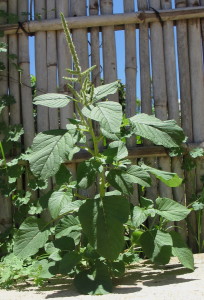
Promotion of lndigenous and Traditional Fruits and Vegetables as Micro-nutríent Sources
Even Amaranthus lividus Can Enrich the Diet
Many plants common in Kenya are used by the local population. Dyes, resins, fuel and oils, sometimes even medicines and nutrients are made from them. Although the eating of wild vegetables and fruits has a long tradition in Kenya, the individual nutritive values and physiological qualities of each were not always known.
This is why in 1987 Kenya’s Ministry of Home Affairs, Natural Heritage, Culture and Social Services started a campaign to increase the use of regional plants to improve the diet of the population. First, the programme gathered data and sought to answers to such questions as: Which plants have been a part of the Kenyan diet? How were these plants cultivated, gathered and prepared? What is the exact nutritive Value of the plants? And how can we promote the cultivation of particularly nutritious plants?
The scientists realized that 2 wild Vegetables common in Kenya – Sukuma and Asystesia schimperi – contained high levels of calcium, iron, phosphor and protein. And other plants such as Baobab, Schlerochyra birrea and Tamarindus indica also proved to be rich in proteins and vitamins. In addition, these plants are easy to dry and preserve.
The Ministry publicized the results in a press information campaign and organized discussions about improving and expanding the cultivation of highly nutritious plants with social organizations, communities and agricultural experts. Seminars and workshops were also held to explain how the public could utilize the research results.
Since then the Ministry has helped establish 12 women’s groups and one youth group. These groups plant the recommended crops for their own use and sell seedlings and seed to neighbouring Villages. In the future, more native wild Vegetables, fruits and grains should be used to produce food for babies and children. Several hospitals offer children under 5 years of age many foods that are prepared mainly with indigenous plants.
